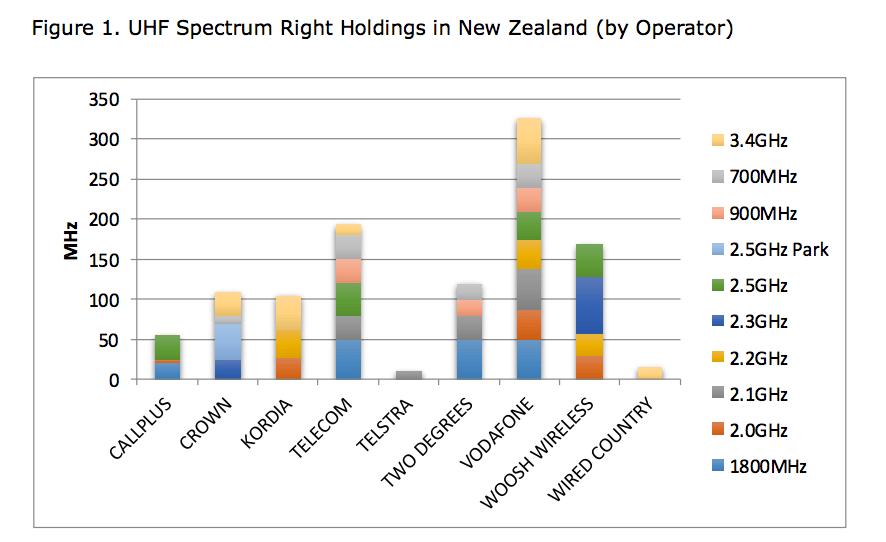Spark winner in NZ mobile spectrum owner shift

Two years ago Vodafone owned more mobile spectrum than any other carrier.
While it still owns the most spectrum, Vodafone’s lead is slipping. It may yet fall further.
We’re seeing a land rush as carriers prepare for the next generation of mobile data services and Spark is grabbing more territory than anyone else.
One feature of 5G mobile is the ability to aggregate spectrum in different bands. In simple terms, the more spectrum a carrier holds, the more wireless bandwidth they have at their disposal. More bandwidth can either mean faster data speeds or a higher number of simultaneous customers.
5G changes the picture
As Analysys Mason explains, 5G cellular will need new spectrum. At the moment much of the potential 5G spectrum is set aside for other uses. From a telco point of view, all existing spectrum investments could be used for 5G, that doesn’t mean they will be.
In the future the carrier with the most bandwidth will be able to dominate the market.
This explains why Spark has pushed hard to catch-up with Vodafone. Depending on how you look at the raw numbers, it may already have overtaken its rival.
For clarity, the spectrum bands currently used for cellular in New Zealand are:
- 850 MHz (Telecom only) – 3G
- 900 MHz (2degrees & Vodafone only) – 2G and 3G
- 1800 MHz (all operators) – 2G and 4G
- 2100 MHz (all operators) – 3G
In the bands currently used for cellular, the operators hold:
- Vodafone: 130.4 MHz
- Telecom: 110 MHz
- 2degrees: 99.6 MHz (some of which is owned by 2degrees’ shareholders, Trilogy Ltd and Hautaki Ltd) .
Starling went on to say:
Soon, the 700 MHz band will also be used for cellular. All three operators will own rights in this band.
The 700 MHz spectrum auction took place soon after the earlier story appeared. By the time it finished, the ratio between the three main carriers in the bands Starling names as used for cellular had changed. Spark (formerly Telecom) picked up 40 MHz, Vodafone took 30 MHz while 2degrees could only afford to buy 20 MHz.
The new holdings are:
- Vodafone: 160.4 MHz
- Spark: 150.0 MHz
- 2degrees: 119.6 MHz
Spark now has almost as much existing cellular spectrum as Vodafone, while 2degrees slipped further behind.
With cellular frequencies, lower numbers are better
On the whole lower frequency spectrum is more valuable than higher frequency spectrum.
Lower frequency signals travel further. This means carriers need to install fewer towers to cover the same number of customers. Signals find it easier to penetrate buildings and pass obstacles at lower frequencies.
In round numbers, spectrum lower than 1 GHz is prime wireless real estate. Staying with round numbers, we can assume the small edge Vodafone has over Spark in terms of absolute spectrum in the bands currently used for cellular is balanced by Spark holding more of the better frequencies.
Some animals are more equal than others
In other words, at the moment, the two companies are about equal when looking at the existing cellular bands. Meanwhile, 2degrees is behind, but not out of touch.
Given the current structure of the cellular industry, 2degrees will need a different strategy to the two big carriers.
So far we’ve only looked at the spectrum that MBIE describes as “currently used for cellular”. That’s not all the spectrum available to carriers. As Analysys Mason points out, with 5G all spectrum potentially comes in to play.
Revisiting the 2013 numbers
This takes us back to late 2013 and Vector’s submission to the Commerce Commission in the run up to the 700 MHz spectrum auction.
In particular is the graph at the top of the page, which shows the New Zealand UHF (ultra-high frequency) spectrum rights holdings in late 2013.
Some of the spectrum shown in this graph wasn’t used for cellular at the time. Some of it still isn’t.
Ratio is important
Yet in simple terms the graph shows that, in late 2013, Vodafone, Telecom — now Spark and 2degrees held spectrum in a ratio of roughly 3:2:1.
In the brave new world of 5G mobile, the absolute amount of usable cellular spectrum in what matters. This ratio defines the potential future power balance between carriers.
So long as we’re talking in round numbers, the 700 MHz spectrum auction left that ratio intact. There was a small shift in Spark’s favour, but not enough to shift the big picture.
Spark moves on Woosh
That changed last week when the Commerce Commission gave Spark permission to buy 70 MHz of spectrum from Craig Wireless that was previously held by Woosh.
In effect Spark now has almost as much UHF spectrum as Vodafone. The two have almost three times as much spectrum as 2degrees.
A back of an envelope calculation estimates today’s UHF spectrum share as:
- Vodafone: 320 MHz
- Spark: 315 MHz
- 2degrees: 120 MHz
This is an estimate based on the Vector graph plus the extra 10 MHz Spark won in the second round of the 700 MHz auction and the 70 MHz Spark purchased from Craig Wireless.
There may be more or overlooked spectrum not included in that last list but unless the overlooked blocks are large, the important point here is that Spark has shifted the 3:2:1 ratio to something closer to 3:3:1.
Disclosure: Bill Bennett has worked as a consultant for Spark Digital.
Member discussion